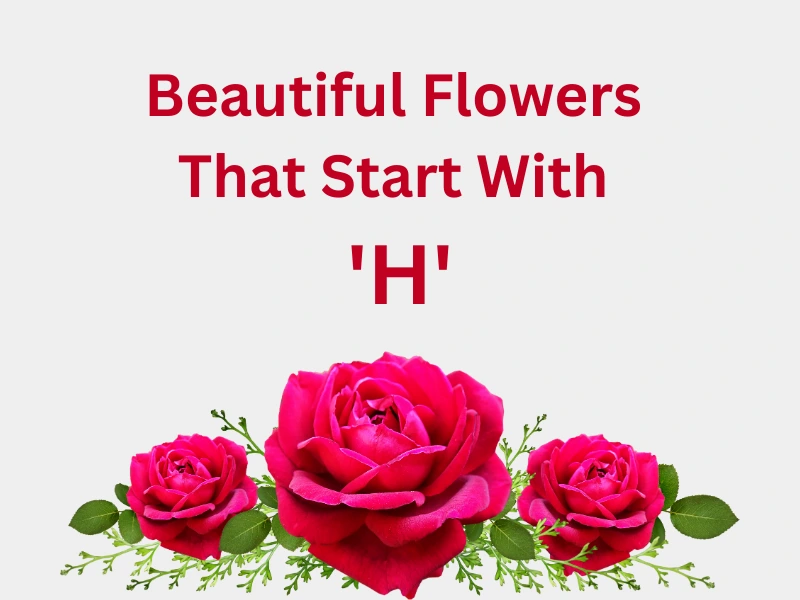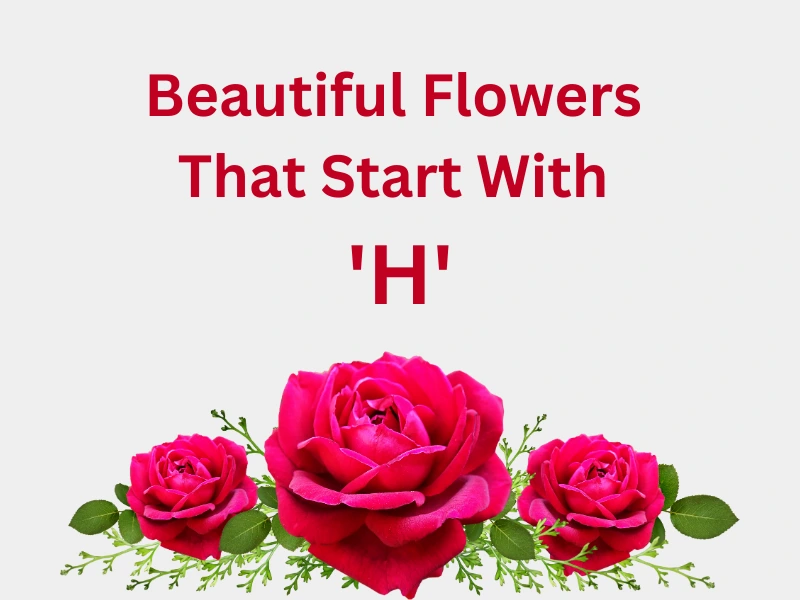
Introduction
Flowers have an innate ability to captivate us with their beauty and charm. Among the vast array of blooms, those that start with the letter “H” hold a special place, showcasing a diverse range of colors, shapes, and scents. In this article, we’ll delve into the enchanting world of beautiful flowers that start with “H” and discover the unique characteristics that make them stand out in the botanical realm.
Hibiscus: The Queen of Tropical Flowers
As we venture into the realm of “H” flowers, we encounter the resplendent hibiscus. This tropical beauty boasts a mesmerizing array of colors, including vibrant reds, pinks, oranges, yellows, and whites. With their large, showy petals and contrasting centers, hibiscus flowers never fail to draw attention.
Hibiscus flowers come in various sizes, from small and delicate to large and extravagant. Each variety has its unique allure, making them a popular choice for gardens, landscapes, and even floral arrangements. Moreover, these flowers hold cultural significance in many regions, symbolizing beauty, love, and delicate beauty.
Hydrangeas: Majestic Blooms in Various Shades
Next on our floral journey are the majestic hydrangeas. These blooms are renowned for their ability to change colors based on the acidity of the soil they grow in. From soft blues to vivid pinks and pure whites, hydrangeas paint the landscape with their stunning shades.
Hydrangeas are shrubs with large, globe-like flower clusters, creating a visual spectacle in gardens and parks. Caring for hydrangeas involves understanding their specific needs, including soil pH adjustments to influence the flower colors. With the right care, hydrangeas can thrive and enchant year after year.
Hellebores: The Winter Roses
While many flowers hibernate during the colder months, hellebores brave the winter chills to grace us with their presence. These enchanting blooms, often referred to as winter roses, add a touch of magic to the winter landscape with their delicate beauty.
Hellebores come in an array of colors, including shades of pink, purple, green, and even black. They boast intricate petal structures that make them look like elegant dancers in the frosty breeze. As a resilient and long-lasting flower, hellebores bring joy to gardeners seeking color during the dreary winter months.
Honeysuckle: The Fragrant Climber
As we continue our exploration of “H” flowers, the sweet-scented honeysuckle beckons us with its delightful aroma. This climbing plant winds its way through fences and trellises, spreading its fragrance all around.
Honeysuckle flowers come in various colors, including creamy whites, soft pinks, and sunny yellows. Apart from their aesthetic appeal, these flowers serve as a valuable food source for bees, butterflies, and hummingbirds, making them a delightful addition to wildlife-friendly gardens.
Hollyhocks: Towering Beauties
Standing tall and proud in cottage gardens and meadows, hollyhocks make a striking impression with their towering height and vibrant flowers. These biennial or perennial plants showcase flowers in various shades, ranging from whites and pinks to deep purples and reds.
With their impressive height, hollyhocks become focal points in any garden, adding vertical interest and elegance. These flowers also attract pollinators, contributing to a healthy and balanced ecosystem.
Heather: A Carpet of Color
Moving on to low-growing flowers, we encounter heather, which forms a delightful carpet of color in various landscapes. Heather’s tiny, bell-shaped blooms cover the plant in hues of pink, purple, and white, creating picturesque scenes in moorlands and gardens alike.
In Scottish culture, heather holds particular significance, symbolizing admiration and good luck. Additionally, heather serves as a valuable food source for bees, making it a vital player in the ecosystem.
Hostas: Not Just Foliage
Often praised for their attractive foliage, hosta plants surprise us with their graceful and delicate flowers. While not as showy as other blooms, hosta flowers have their own understated charm, adding a touch of elegance to shaded gardens.
Hosta flowers come in various colors, including shades of purple, lavender, and white. Amidst their lush leaves, the flowers create a harmonious and balanced display. Proper care, such as providing sufficient shade and moisture, ensures healthy hosta plants that bloom year after year.
Heliotropes: The Scent of Vanilla
One of the most delightful aspects of the heliotrope flower is its sweet fragrance, reminiscent of vanilla. These small, clustered blooms add a touch of old-fashioned charm to any garden, emitting a delightful aroma that lingers in the air.
Heliotropes thrive in sunny locations, where they can bask in the warmth and release their delightful scent. With their timeless appeal, heliotropes add a nostalgic touch to gardens and evoke memories of bygone days.
Hibbertias: Australian Golden Stars
While lesser-known, hibbertias prove to be gems of the floral world. Native to Australia, these charming flowers boast star-shaped petals and come in various shades of yellow, adding a touch of sunshine to landscapes.
Hibbertias are hardy and adaptable, making them suitable for a range of climates. Their bright blooms bring cheer to gardens and provide nectar for native pollinators.
Helenium: Autumn’s Sunshine
As autumn arrives, helenium flowers bring the sunshine back into our lives with their warm and vibrant colors. These daisy-like blooms showcase shades of red, orange, and yellow, brightening up the fading landscape.
Heleniums are an excellent addition to fall gardens, extending the blooming season and attracting bees and butterflies during their migration. To enjoy a burst of autumn colors, gardeners can provide these flowers with well-drained soil and ample sunlight.
Himalayan Blue Poppies: Rare and Captivating
Among the most elusive flowers, the Himalayan blue poppies captivate our hearts with their stunning blue hues. These rare and delicate blooms require careful attention to thrive, making them a rewarding challenge for dedicated gardeners.
Himalayan blue poppies need cool and moist conditions, often thriving in shaded areas with ample humidity. Despite their finicky nature, these extraordinary flowers offer a once-in-a-lifetime sight for those fortunate enough to witness them in full bloom.
Hibiscus Syriacus: The Rose of Sharon
The hibiscus syriacus, commonly known as the Rose of Sharon, boasts a striking resemblance to roses with its elegant flowers and abundant petals. These long-lasting blooms come in various colors, adding a touch of sophistication to any garden.
Hibiscus syriacus is a hardy shrub, requiring minimal care to flourish. With their beauty and endurance, these flowers become a symbol of resilience and grace in the garden.
Hoya: The Wax Plant
The hoya plant, often referred to as the wax plant, enthralls us with its waxy and fragrant flowers. These unique blooms emerge in clusters, releasing a delightful scent that lingers in the air.
Hoyas thrive in bright and indirect light, making them suitable for indoor and outdoor cultivation. With their intriguing appearance and sweet fragrance, hoyas become prized possessions for flower enthusiasts.
Conclusion
The world of beautiful flowers starting with “H” is a captivating one, offering a diverse array of colors, scents, and forms. From the tropical allure of hibiscus to the fragrant charm of honeysuckle, each flower holds its unique appeal, adding beauty and wonder to our surroundings.
As we embrace the beauty of “H” flowers, let us celebrate and cherish these magnificent blooms. Whether adorning gardens, landscapes, or floral arrangements, these flowers remind us of the ever-present splendor of nature.
FAQs
1. Which “H” flower is best suited for my sunny garden?
- If you have a sunny garden, consider planting hibiscus or heliotropes. Both thrive in full sunlight and offer eye-catching blooms.
2. Can I grow hellebores in containers?
- Yes, hellebores can be grown in containers, provided they have good drainage and are placed in a sheltered spot during winter.
3. Are hibbertias suitable for cold climates?
- While hibbertias are native to Australia, some varieties can tolerate colder climates. Check for cold-hardy options if you live in a colder region.
4. How often should I water hydrangeas?
- Hydrangeas prefer consistently moist soil, but not overly saturated. Water them deeply once or twice a week, depending on the weather.
5. Do Himalayan blue poppies bloom every year?
- Himalayan blue poppies are short-lived perennials and may not bloom every year. They require specific conditions to thrive and may take some time to establish.


